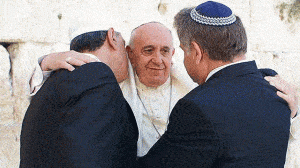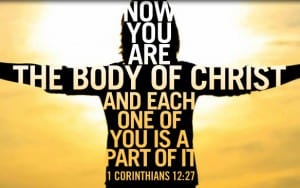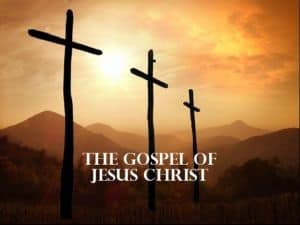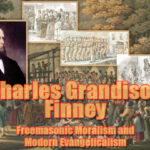How often we hear a call for “unity” in the church today. Is it scriptural?
Dangers of the Ecumenical Movement | by Dr. Opal Reddin, Professor Emeritus of Central Bible College (Abridged by HHA)
The contemporary Ecumenical movement is as dangerous as the coming of the Judaizers to the Early Church was with their false “gospel” of “Jesus plus works of law” (Acts 15:1; Galatians 1:6-9; 2:1-21).
The Judaizers were so influential that even Peter and Barnabas were temporarily drawn away.
Paul immediately and publicly accused them of hypocrisy and pronounced the curse of God on the false “gospel.”
Peter and Barnabas saw the Truth, repented, and joined with Paul in the first Council of the Church in Jerusalem, where the Holy Spirit led the Church to settle the message of the Gospel for all time (Acts 15:2-28).
The leader of the Ecumenical movement is the Roman Catholic Church; which teaches the same heretical “Jesus plus works for righteousness” message as the Judaizers.
Like Paul and the Apostles, we have the blood-bought privilege of preaching the Gospel of “Jesus plus nothing.” Through the finished work of Calvary, Jesus Christ provided our full Salvation. He “became for us wisdom from God and righteousness and sanctification and redemption” (1 Cor. 1:30).
Biblical Church Unity
The Church is the Body of Christ, the habitation of God through the Spirit. Every one who is born of the Spirit is a member of the “church of the Firstborn, which are registered in Heaven” (Heb. 12:23). The Church is:
Universal with some from every tribe and nation.
Invisible in the sense that it is impossible to see the Church as a definite group in a definite place. All creation waits for the manifestation of the sons of God (Rom. 8:19).
One of the most popular topics in Christian circles today is “Church Unity.”
Many leaders are saying, “We must get together and bring the answer to Jesus’ prayer in John 17.” Let us consider the kind of unity for which Jesus prayed, the fact that His prayer was answered, and that His prayer continues to be answered, according to His will as revealed in the Word.
Jesus prayed for His disciples: “that they may be one just as We are One” (v. 22b).
He said, “I do not pray for these alone, but also for those who will believe in Me through their word” (v. 20).
We are awed as we contemplate God the Son praying to God the Father that we might have the same kind of unity as that existing between them! Let us consider what kind of unity this is.
First, this unity is spiritual.
The Father and the Son are one in essence from eternity to eternity (John 17:5; 10:30). We know God is Spirit (John 4:24) and that God the Son in His incarnation became man with a physical body (John 1:14). Their essential unity was never broken because it is spiritual and immutable (John 10:30).
Second, this unity is in truth.
Jesus said, “I Am the Truth” (John 14:6), and He prayed, “Sanctify them through Your truth; Your Word is truth” (John 17:17).
Third, we see that this unity is in love.
He prayed, “that they may be perfect in one, and that the world may know that You have sent Me, and have loved them as You have loved Me. . . that the love with which You loved Me may be in them” (John 17:23,26).
Jesus’ Prayer is Answered
Jesus’ prayer for unity was answered initially on the day of Pentecost, and the Spirit-given unity was manifested in the Early Church. Acts records what we often refer to as the birth of the Church. The 120 + 3000 were brought into spiritual unity as all were filled with the Holy Spirit (2:4,38,41). They were in unity in the Truth, “continuing steadfastly in the apostles’ doctrine” (2:42).
All Scriptures that refer to church unity make clear that the true Church, the Body of Christ, IS ONE.
The only way to be in the true Church is to be placed in the Body of Christ by the Holy Spirit in regeneration; “the Body is one . . .all the members are one . . . for by one Spirit we were all baptized into one Body” (1 Cor. 12:12-13). “He that is joined to the Lord is one spirit with Him” (1 Cor. 6:17). “You are all one in Christ Jesus” (Gal. 3:28).
Nowhere are we Admonished to Implement this Unity.
Ephesians 4 does tell us we are to keep the unity of the Spirit in the bond of peace” (v.3), and that Jesus gave the five-fold ministry for the perfecting of the Body “till we all come to the unity of the Faith . . .to a perfect man, to the measure of the stature of the fullness of Christ” (11-13). “The Faith” is the body of orthodox Christian doctrine, well known to the Early Church and preserved for us in the New Testament.
Unity in Doctrine is Essential
We agree with David Wells (No place for truth or Whatever happened to evangelical theology? 1993:103) when he says, “there is no Christian faith in the absence of ‘sound doctrine’ (1 Tim. 1:10; Tit. 1:9).” Without it, we have neither the Father nor the Son (2 John 9). We are told to “contend earnestly for the faith once for all delivered to the saints” (Jude 3). We must “guard” this faith (2 Tim. 1:13-14; 4:3). We know that this faith was stated in propositional truths, for Paul wrote to the Corinthians: “I plead with you that you all speak the same thing and that there be no division among you, but that you be perfectly joined together in the same mind and in the same judgment” (1 Cor. 1:10). It is on this basis that churches have statements of fundamental truths. Belief and practice are inextricably linked (1 John 2:3–3:18).
There are Two Kinds of Division, one of God and the other of Satan.
When Paul warned against division, he was referring to bad division, caused by false doctrine. Some “depart from the faith, giving heed to seducing spirits and doctrines of demons” (1 Tim. 4:1). In John’s Epistles he warned, “Many antichrists have come . . .they went out from us, but they were not of us” (1 John 2:18-19). Regarding fellowship, he wrote, “If anyone comes with another doctrine, do not receive him . . .for he who greets him shares in his evil deeds” (2 John 10,11). Paul told the Romans to “mark those who cause division contrary to the doctrine which you have learned” and avoid them (16:17).
There is Good, necessary division.
The result of good necessary division is being separated from Error by the Truth (John 17:17). Jesus said, “I came to bring division” (Luke 12:51); He separated His Church from the Judaism that rejected Him (John 1:11). Paul maintained this separation by exposing the Judaizing heresy as “another (accursed) Gospel” (Gal. 1:6-9). Without this division, Christianity would have gradually become merely a sect of Judaism.
Problems in current Ecumenical Movements
The World Council of Churches has included as participants at conferences, not only all Christian churches, but also adherents of non-Christian religions. For instance, the 1991 conference in Canberra, included Jews, Muslims, Buddhists, Hindus, and Sikhs; a Korean Presbyterian professor near the end of her lecture summoned the spirit of Han and chanted to the departed spirits of ancestors.
The Roman Catholic ecumenical movement works in various ways. The New Catechism has not changed the insistence that there is no salvation outside the Church, referring to the Church in Rome. All the objectionable doctrines are still there, including baptismal regeneration, grace inherent in the Mass through transubstantiation, prayer to Mary, indulgences, and purgatory. Their “salvation” is a “faith plus works,” the same Judaizing heresy anathematized by Paul (Gal. 1:6-9).
The goal of Catholic dialogue with other faiths is to bring all Christians together in the One Church.
In the Decree on Ecumenism, they state their purpose: “The results will be that, little by little . . .all Christians will be gathered . . .into the unity of the one and only Church. . . . This unity, we believe, subsists in the Catholic Church as something she can never lose.” They also make the umbrella of the Church big enough to cover those in some non-Christian religions: “The plan of salvation includes those who acknowledge the Creator [Muslims and Jews]; together with us they adore the one, merciful God.”
The Roman Catholic Church’s doctrinal position can be summarized as follows:
They agree that the Scriptures are inspired, but they also insist that the Catholic Church is the higher authority and that Scripture must be interpreted according to their Tradition (Vatican II, Dei Verbum).
They accept the Deity of Christ, but worship Mary as “Mother of God,” destroying the meaning of “Deity” (Catholic Catechism, 25).
They believe in the universality of sin; but insist that the merit of Jesus Christ is applied to infants by the sacrament of baptism and by baptism the guilt of original sin is remitted (Council of Trent, 22, 23, 54). As children grow up, their sins are dealt with by the unscriptural doctrines of Penance, Confession to priests, Indulgences, and finally the fires of Purgatory.
They believe in Christ’s substitutionary atonement,” but for Catholics there is no justification by Christ alone. “For it is through Christ’s Catholic Church alone that the means of salvation can be obtained.” – Decree on Ecumenism .
They say Christ makes salvation possible, but He is only one of the means of justification. Other essential means of grace include the Sacraments of Baptism and the Eucharist, efficacious only when administered by the Catholic Church. They also insist that “Mary is truly Mother of the Church and brings birth of believers” (Catechism of the Catholic Church, 25).
They profess faith in the physical resurrection of Christ and His second coming, but they insist that no one can be ready for that event without going through the cleansing fires of purgatory.
They teach that Purgatory exists because “the saved must be purged before entering Heaven” (Catechism, 268).
Danger: the loss of TRUTH
In 1994 a group of Catholic leaders and Evangelical leaders drafted a document known as ECT, short for “Evangelicals and Catholics Together in Mission.” Having read the document, I find it to be a plea for visible unity at the expense of Truth. For example, the one absolute essential for being in the true Church, “justification by faith,” is barely mentioned, though it is one of the major doctrines that irrevocably divide Protestants and Catholics. ECT forbids “proselytizing.” In practice, it would stifle the evangelizing of Catholics. Effectively, millions of lost souls will have to be left in the darkness of a false “Gospel” for the sake of man-made “unity.”















